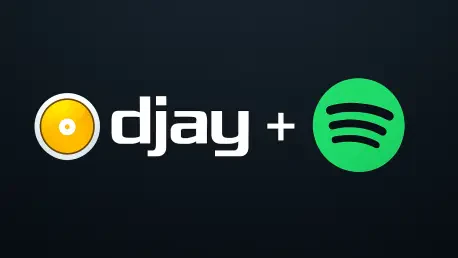What happens when a dedicated DJ app gains access to the world’s largest music streaming library, threatening to outshine the platform’s own mixing tool? Picture a bedroom DJ seamlessly blending tracks from Spotify’s vast catalog with professional-grade effects, all without ever leaving a single software. Algoriddim’s djay has made this a reality with its recent Spotify Premium integration, sparking a heated debate among music enthusiasts and aspiring mixers. This clash pits a standalone app’s advanced features against the convenience of Spotify Mix, raising questions about the future of digital music creation.
Why This Audio Clash Matters
The integration of Spotify Premium into djay isn’t just a technical update; it’s a bold challenge to the status quo of how music is mixed and consumed. With millions of tracks now directly accessible for mixing on Mac and Windows, djay empowers users to create complex sets that rival professional outputs, all while tapping into personal playlists. This development matters because it bridges the gap between casual listeners and serious DJs, potentially reshaping user loyalty in a competitive audio landscape where streaming giants like Spotify strive to keep creativity within their own ecosystems.
The stakes are high as the demand for music mixing tools surges. Standalone apps and in-app features are vying for attention in a market where, according to industry reports, over 60% of streaming users experiment with playlist customization. The outcome of this rivalry could dictate whether specialized tools like djay carve out a larger niche or if built-in options like Spotify Mix retain dominance through sheer accessibility.
A Growing Appetite for Mixing Mastery
The digital music scene is witnessing an unprecedented hunger for tools that transform listeners into creators. Casual users want to craft memorable party vibes, while budding DJs seek platforms to refine their craft without breaking the bank. Standalone apps have gained traction by offering intuitive designs paired with powerful features, catering to a wide spectrum of skill levels in a way that streaming services are scrambling to match.
This trend reflects a broader shift in audio interaction. A recent study revealed that nearly 40% of young adults have tried mixing or remixing tracks using mobile or desktop apps, highlighting a cultural move toward personalization. As streaming platforms race to embed mixing features, the competition is no longer just about music access but about empowering creativity at every level.
Djay vs. Spotify Mix: A Feature Face-Off
Diving into the specifics, djay’s integration with Spotify Premium offers a transformative experience for desktop users. Imagine dragging a track from a curated playlist, applying beat-matching, and layering effects for flawless transitions—all without downloading a single file. This seamless access to millions of songs, combined with support for DJ hardware, positions djay as a powerhouse for those craving a hands-on, professional feel.
On the other hand, Spotify Mix prioritizes simplicity for its massive user base. Embedded directly in the Spotify app, it allows basic playlist tweaks and fades, perfect for quick, effortless blends. While it lacks the depth of track looping or advanced effects, its universal availability across devices gives it an edge for everyday listeners who value convenience over complexity.
The divide is clear: djay targets users willing to invest time in mastering intricate tools, while Spotify Mix caters to the masses with minimal barriers. This contrast underscores a fundamental split in the market, where the choice hinges on whether depth or ease takes precedence for individual needs.
What Users Are Saying About the Showdown
Feedback from the field reveals a polarized landscape. A seasoned hobbyist shared in a popular online forum, “Djay’s Spotify integration is a game-changer for crafting detailed mixes, but it’s not as intuitive for a quick session as Spotify Mix.” Such sentiments echo across DJ communities, where the consensus praises djay’s robust capabilities but acknowledges a steeper learning curve that might intimidate beginners.
Market insights further illustrate this split. Algoriddim reported a 20% spike in user growth following the integration, signaling strong appeal among dedicated mixers. Yet, with Spotify boasting billions of active users, its in-app feature naturally captures a wider, more casual audience, highlighting that neither tool is likely to claim total victory anytime soon.
These voices emphasize a critical point: success depends on user priorities. For every enthusiast diving into djay’s advanced toolkit, countless others stick with Spotify Mix for its no-fuss approach, painting a picture of a fragmented yet dynamic user base.
How to Navigate These Mixing Options
For those eager to jump into the mixing game, choosing the right tool depends on specific goals. Desktop users with Spotify Premium can download djay on Mac or Windows, connect their accounts, and experiment with detailed tutorials on beat-matching and effects. This setup suits anyone aiming to build intricate sets or prepare for live performances with connected hardware.
Conversely, casual listeners across any device might find Spotify Mix more practical. Simply open the app, adjust playlists with basic fade options, and share creations instantly without additional software. It’s a straightforward choice for spontaneous mixing or background tunes at a gathering.
For mobile users outside djay’s current Spotify integration scope, exploring alternatives like Tidal or Apple Music within djay’s iOS app offers a workaround. The key lies in aligning the tool with the intended use—opt for djay when depth is essential, or lean on Spotify Mix for quick, accessible results.
Reflecting on a Sonic Rivalry
Looking back, the battle between djay and Spotify Mix unfolded as a fascinating study in innovation and user choice. The integration of Spotify Premium into djay marked a pivotal moment, offering a glimpse into how specialized tools could elevate music creation for dedicated enthusiasts. Meanwhile, Spotify Mix held its ground, proving that simplicity and reach often outweigh complexity for the average listener.
As this rivalry evolved, it became evident that both platforms addressed distinct needs, shaping the audio landscape in unique ways. For those inspired to dive deeper, the next step was to experiment with these tools firsthand—test djay for ambitious projects or rely on Spotify Mix for effortless blends. The future promised even tighter competition, with potential expansions like mobile integration for djay hinting at new chapters in this ongoing sonic saga.









